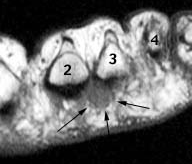Patients commonly present with pain toward the "ball of the foot" and invariably have undertaken the obligatory GOOGLE search only to conclude they have either a Morton's neuroma or "metatarsalgia". The term "metatarsalgia" of course is not a diagnositc term but simply means "pain the metatarsals".
The pitfall for patients and the unwary clinician alike are the varied and overlapping signs and symptoms presenting by very different underlying conditions. Unfortunately disease processes simply refuse to the follow the rules of presentation set out in textbooks on foot disorders.
For example the classical burning pain of a true Morton's type neuroma is also seen in other cause of forefoot pain such as acute bursitis, other tumours as well as radiculopathy. Equally problematic is that many pathologies can present without classical features. About 25% of the Morton's neuromas I see in clinic have no associated distal paraesthesia associated with them and or no definitive Mulder's sign.

The astute clinician will of course tease out the relevant patient history and key findings from the physical examination to produce a short list of diagnostic possibilities. Where necessary imaging like the MRI can be selected to confirm rather make the diagnosis.
In the case of forefoot pain the initial differential diagnosis is a lengthy one and might include:
- Tendinosis
- Capsulitis
- Arthropathy
- Neuroma
- Bursitis
- Avascular necrosis
- Tumour
This is by no means a complete list but serves to illustrate the range of possible conditions that can present as so-called "metatarsalgia". The picture below is a patient of mine who had been treated with an array of beautiful orthoses for what was believed to be a Morton's neuroma.

The x-ray actually confirms degenerative changes within the head of the third metatarsal (white arrow). This is the result of an avascular necrosis resulting in flattening of the head of the metatarsal head which over time has resulted in secondary osteoarthrosis.
So next time you see a patient with pain in the ball of the foot, give some thought to the range of possible causes of the pain and don't get caught out. Remember being a good clinician begins with making the right diagnosis.
The Foot Consultant
